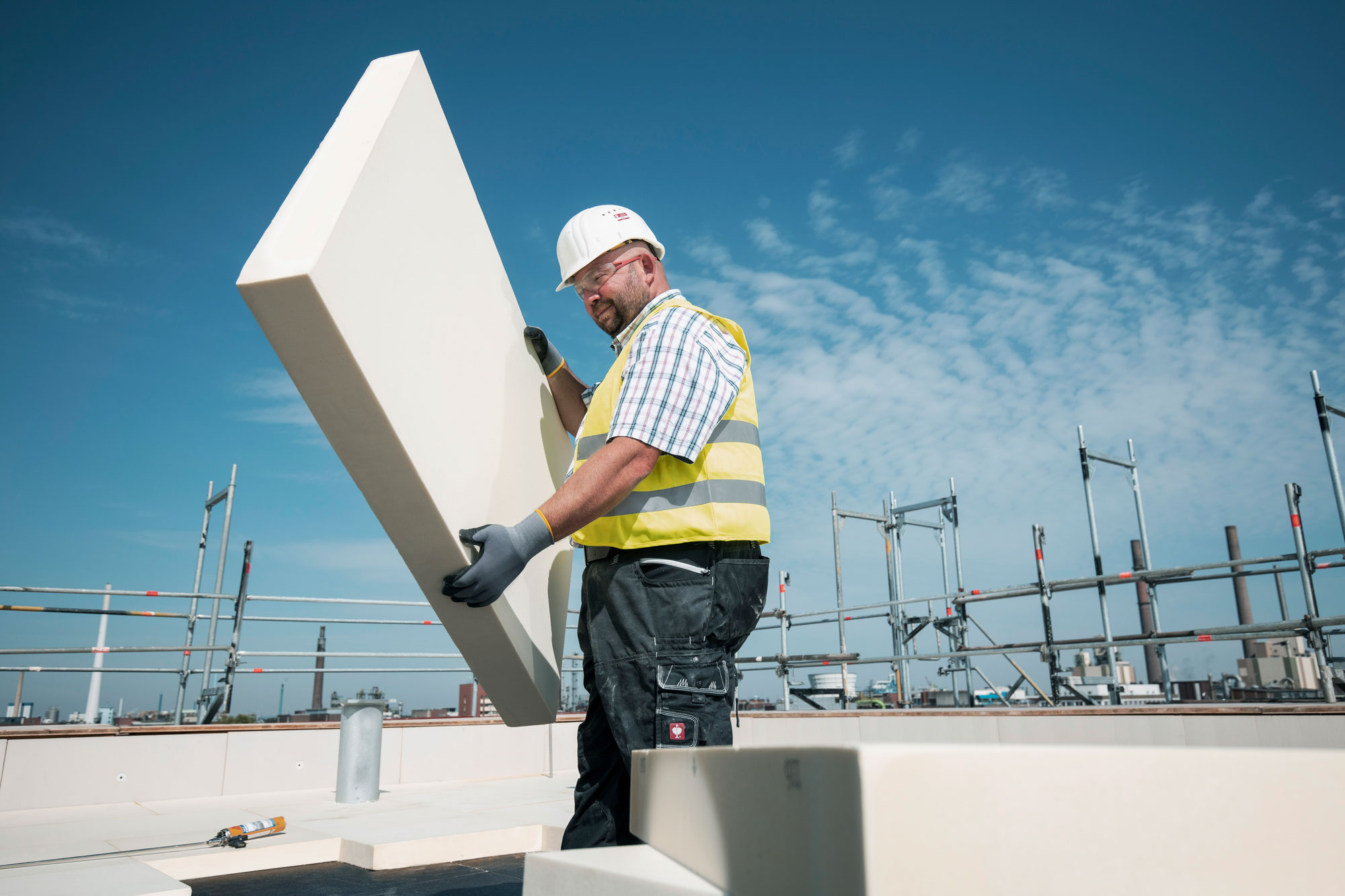Story at a glance:
- Buildings, materials, and all of the infrastructure that support them require a huge amount of energy.
- The building and construction sector is responsible for nearly 40% of global energy-related carbon emissions.
- Covestro and others joined clean energy ministers, experts, and advocates from across the globe in Pittsburgh recently for the Global Clean Energy Action Forum.
With awareness growing about the built environment’s impact on the climate, it should come as no surprise that change is on its way.
In countries around the world, shifts toward decarbonizing the spaces and places that comprise the built environment have the potential to transform the building and construction sector in profound ways in the very near future.
And it’s no wonder.
High-rise office buildings, residential homes, the electric grid, building materials and products, manufacturing facilities, and our transportation infrastructure all require enormous amounts of materials and electricity. Until now designing, constructing, operating, and powering buildings, communities, and cities have all relied heavily on fossil fuels. Combined with sometimes inefficient practices and processes, the result has been substantial greenhouse gas emissions.
Today the building and construction sector is responsible for almost 40% of global energy-related carbon emissions, 50% of all extracted materials, with 36% of energy consumption coming from buildings. At the same time the sector represents a $24.7 trillion investment opportunity in emerging markets alone.
“That means decarbonizing the built environment presents a tremendous opportunity and priority due to its significant impacts on climate change, human health, social equity, and economic vitality,” says Jenna Cramer, president and CEO of Pittsburgh-based Green Building Alliance (GBA).
With clean energy ministers, experts, and advocates from across the globe convening in Pittsburgh recently for the Global Clean Energy Action Forum, decarbonizing the built environment was the sole focus of an all-day workshop hosted by Green Building Alliance and Covestro, along with others. Together these policymakers and practitioners shared strategies and solutions for getting to zero or near zero emissions in the built environment.
From mitigating methane and embodied carbon, building and energy codes, sustainable cooling and beneficial electrification to financing the clean energy transition and decarbonizing manufacturing processes and supply chains using circular economy principles, these were among the issues addressed at the workshop, which was held at one the greenest buildings in the world—Phipps Conservatory and Botanical Gardens.
Both GBA and Covestro are committed to the UN Sustainable Development Goals and mitigating climate change. The workshop was an opportunity to advance those efforts and add important insights to a roadmap for the built environment’s transition.
Here are some insights from the event.
GBA & the Global Clean Energy Action Forum

Sustainability experts gathered in Pittsburgh as part of a workshop focused on decarbonizing the built environment. The event was hosted by the Green Building Alliance and Covestro. Photo courtesy of Covestro
As Greater Pittsburgh’s authority on sustainable design, GBA had been working with the Clean Energy Ministerial and was the perfect fit for organizing the workshop.
GBA champions cutting-edge research and equips designers, manufacturers, developers, and policymakers with the tools they need to drive systemic change around constructing and operating the most advanced, energy-efficient buildings in the world.
For nearly 30 years the organization has been working to create a built environment throughout Western Pennsylvania and beyond that addresses climate change, advances human health, achieves social equity, and creates thriving economies.
It’s a tall order, but one GBA—one of the nation’s oldest regional green building organizations—continues to deliver on. With its experience managing the largest 2030 District in the country, it is driving deep energy reduction targets for the existing building sector while advancing near zero performance for new construction.
Because of GBA’s exemplary work, the United Nations Economic Council for Europe launched the Greater Pittsburgh International Center of Excellence on High Performance Building in 2019. In doing so Pittsburgh became part of a global network of sustainability experts working to advance UNECE’s Framework Guidelines for Energy Efficiency Standards in Buildings.
Covestro’s Commitment to Circularity and Climate Neutrality
Back in Pittsburgh, GBA turned to Covestro because of the company’s innovative work around the circular economy and climate neutrality and because of the unique space it occupies within the built environment.
As one of the world’s largest chemical and polymer companies, not only are Covestro’s facilities part of the built environment itself, but its products—polycarbonates, polyurethanes, and precursors for coatings, adhesives, and sealants—are used in products throughout the construction industry, among many others.
“That means Covestro can help accelerate decarbonizing the built environment by offering climate neutral products for these industries, using alternative raw materials, renewable energy, and climate neutral production and operational processes to produce them—the very things we are already doing,” says Haakan Jonsson, chairman and president of Covestro.
Plus, it’s leading the chemical industry in its use of the circular economy principles of reuse, recycle, and repair in its processes.
In fulfilling its goal to become operationally climate neutral by 2035 and a circular economy company in the long-term, Covestro has used these approaches to pioneer the world’s first cradle-to-gate climate neutral polycarbonate. This versatile, high-tech plastic is used in LED lighting, electric vehicles and charging infrastructure, automotive headlamps, medical devices, and consumer electronics, to name a few.
The company’s MDI, a key raw material in the production of rigid polyurethane foam, is also available in a cradle-to-gate, climate-neutral version. It becomes the insulation that increases energy efficiency in the building envelope and in household appliances, like refrigerators and water heaters.
Key Takeaways on Policy
The workshop yielded a mix of policy and practical news and trends for the green building industry. For now we’ll look at some of the important policy takeaways from the day.
After Paris and Glasgow, a Buildings Breakthrough
The Global Alliance for Buildings and Construction (Global ABC) was launched by France and the United Nations Environment Programme in 2015 at COP21 when the now well-established Paris Agreement was adopted internationally.
Its aim: Achieving a zero-emission, efficient, and resilient buildings and construction sector.
A voluntary organization of governments, NGOs, businesses, and think-tanks, it operates as a network of networks, connecting initiatives and individuals working in the space. A largely technical entity, the Global ABC works to set targets and track progress through various reporting tools and indices, as well as help countries set priorities and measures based on their situation.
The one missing piece, according to Mark Radka, has been the political or policy component. Radka, chief of the Energy and Climate Branch at United Nations Environment Programme, the organization that oversees the Global ABC, says that is now changing.
Recently France and the Kingdom of Morocco announced they would co-lead a Buildings Breakthrough using the Glasgow Breakthrough Agenda as a framework. The agenda focuses on decarbonization of high emitting sectors like transport, power, steel, and agriculture. The new Buildings Breakthrough, with support from the Global ABC, is a major milestone for the sector.
It is expected to have a revolutionary and evolutionary impact on the buildings and construction sector, essentially requiring all involved to rethink the approach to development, beginning at the earliest possible stages.
“Morocco is actively involved in the low carbon energy transition of the built environment and is deploying various measures and reforms in terms of regulation, standardization and collaboration between professionals,” says Majida El Quardirhi, secretary-general of the department for housing and city policy in the Ministry of National Territory Planning, Urban Planning, Housing and City Policy for the Kingdom of Morocco.
The Clean Energy Transition Must be Just
The World Economic Forum estimates that by 2030, the 2.7 million jobs lost in fossil fuels sectors will be offset by roughly 10.3 million net new jobs created globally from the transition to clean energy.
While that is good news, those 2.7 million workers must not be left behind. They, along with women and people of color who have been largely underrepresented in the building/construction and energy sectors, must be brought into the clean energy economy.
“Transitioning the built environment to clean energy involves a uniquely human element because it impacts so many people’s lives and livelihoods,” says GBA’s Cramer. “So any and all solutions must align with the UN Sustainable Development Goals, Paris Agreement, UNFCC Human Settlements Climate Action Pathway, and Glasgow Breakthroughs, while considering best practices from networks like the Global Alliance for Building and Construction and UNECE High Performance Buildings Initiative.”
Financing Clean Energy
Transitioning the built environment to clean energy is an expensive proposition. It requires innovative financing and impact investing from diverse sources.
The 2022 Inflation Reduction Act in the US opens up more than $350 billion in federal funding for clean energy transformation and converting plants that run on fossil fuel to nuclear or renewable energy.
In addition, the Cities Climate Finance Leadership Alliance brings innovators and investors together to ensure bankable climate change projects and technologies are being greenlit in cities. Launched at the UN Climate Summit in 2014, it provides its members with access to best practices and tools related to financing and project design, as well as opportunities to collaborate with public and private sector partners on policy design and financing instruments.
“Time after time, I find lack of investment [is the biggest challenge]. When we look at energy transitions in countries like Ukraine or India, the amount of money required to reclaim land, restore it, repurpose it and make it ready for the 21st century is enormous,” says Ray Pilcher, chair of the Group of Experts on Coal Mine Methane, UNECE, and owner and founder Raven Ridge Resources.
Collaboration and Networks will Drive Built Environment Decarbonization
Whenever there is change, people tend to be risk averse. No one wants to be the first. They want someone else to work out the kinks.
Still, best practices are everywhere. The question is: How, where, and to whom are they being disseminated? Almost every expert in attendance agreed this needs to be handled through collaboration and networking. As the old saying goes, “No one is as smart as everyone.”
In order to drive innovation and deployment of clean energy technologies, better alignment and cooperation are needed among and between countries, government agencies, NGOs, industries, businesses, and citizens. The good news is networks already exist and are working.
One mentioned earlier is UNEP’s Global ABC. A network of networks, it has grown from 79 members to more than 200 members spanning 34 countries. It is forging building decarbonization pathways with a global roadmap for members. For the last six years Global ABC has issued status reports for tracking progress on meeting near or net zero goals.
Another is the Greater Pittsburgh International Center of Excellence on High Performance Building led by GBA. A public-private partnership consisting of more than a dozen regional governments, corporations and organizations, the Center for Excellence connects building performance to country commitments and targets. Recently, it established a formal partnership with Penn State University to create the Global Building Network, which engages in interdisciplinary research to drive education and outreach.
The Bottom Line
Achieving the global ambition of decarbonizing the built environment is eminently doable. We know this because it is being done. One of the best examples is at Phipps Conservatory and Botanical Gardens. Its Center for Sustainable Landscapes is one of the greenest buildings in the world. It is a net zero energy or net positive energy building that has no heating, cooling or electric bills.
Still, the work requires all stakeholders to put this kind of know-how and these much-needed policies in place, urgently. It’s the only way to ensure long-term sustainability for the environment, the economy and society at large.


